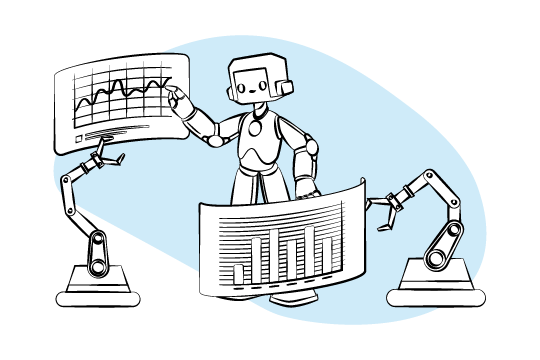When you hear of mentions of artificial intelligence, the most immediate thought that could come to mind is a technology that now allows machines (including computers) to mimic human intelligence and problem-solving abilities. And just like this technology is transforming other sectors of life, so is it in the crypto industry. AI boasts a sophisticated data analytic capacity that helps monitor mining rigs and adjust operations depending on market conditions.
Well, in 2024, we have not stopped seeing this technology further transforming the crypto-mining sector. If you are among those who play a close watch on crypto, then you can agree that this is something to watch. In this article, you will get a general overview of how AI enhances crypto mining and what you can expect in the future.
The Real Benefit of AI
We live in a digital era where almost everyone is grappling with the issue of big data. This is not only limited to the crypto industry alone but also includes other sectors like the casino, movie and music industries. In the casino sector, for instance, you’ve seen more online platforms emerging to afford players the convenience of accessing gambling products from any place. From offering live casino games, online table game variations and many other categories, these online platforms ensure you can enjoy entertainment at your own convenience.
In the movie and music industries, you can agree that Spotify and Netflix have entirely changed how we consume music and movies. Now, amid these tech advancements, providers can sometimes be faced with the challenge of dealing with a vast amount of consumer data – especially now that more fans can access these platforms. And that’s where AI now comes in. This technology has quite a robust capacity that enables it to crunch enormous amounts of data to extract meaningful insights.
In crypto mining, artificial intelligence enhances efficiency by allowing mining rigs to adjust parameters like hash rates, ensuring optimal performance. With this, you can always be sure of a higher throughput. Plus, you can integrate AI into the risk assessment tools to boost real-time monitoring of market conditions and regulatory developments. This helps ensure you can draw valuable insights and navigate uncertainties more effectively.
Enhance energy consumption in crypto mining through AI
Energy consumption is a common challenge you might have witnessed in the crypto-mining sector. Given that humans could struggle with optimizing crypto operations, AI emerges as a good-to-go-to solution that can streamline these processes. Well, even though this area remains a subject of discussion, you’ll be surprised to note that the combined power that mining rigs use worldwide could equal that of some small countries.
On top of this, the high energy costs could also eat into the mining profits. So, you will see a trend where individual miners opt to join mining pools to operate optimally. This might always be the best route, especially since crypto-mining markets are increasingly competitive. Therefore, AI-based energy-efficient mining algorithms have emerged to cut down on energy consumption.
Just recently, in 2023, CryptoBlox announced that it would partner with Lavrium to facilitate efficient consumption. The organization would achieve this by using Lavrium’s AI to analyze factors like power usage effectiveness and hash rates, allowing Redwater, its subsidiary, to get maximum returns on energy investments. When you look at the future of data processing in crypto mining, there’s no doubt that the processes will become faster. Although still in theory, AI will transform this phase, particularly because it can solve problems and automate in real-time, even with non-quantum computers.
AI in the midst of Bitcoin halving
The Core Scientific Story
Towards the end of the 2024 first quarter, an event that happens once every four years happened – bitcoin halving. If you’re a crypto enthusiast, you probably witnessed how several businesses received it with mixed feelings. Analysts from JPMorgan Chase stated that some operators were feeling a pinch and actively looking at exit strategies.
Since generating new tokens has become less profitable, bitcoin miners, mergers and partnerships are joining hands to find ways of generating greater returns. In June of this year (2024), Core Scientific, a US bitcoin miner, confirmed an expanded deal with Coreweave, a startup specializing in chipmaker’s technology for running artificial intelligence algorithms.
In the agreement that would generate an extra $1.2 billion in revenue for over 12 years, Core Scientific agreed to provide 70 megawatts of infrastructure to facilitate CoreWeave. This infrastructure would increase to 270 by the second half of 2025.
The Hut 8 Story
As AI firms thirst for power, bitcoin miners are crashing in. In June 2024, Hut 8, a Miami-based company, saw its shares outperforming most of its peers after raising about $150 million from Coatue to help construct an AI infrastructure. During its first-quarter earnings report, the company confirmed that it had bought 1000 Nvidia GPUs (first batch) and had already signed a customer contract with a venture-backed AI cloud platform.
Other companies like Bit Digital are also joining in this trend. In June 2024, Bit Digital, which receives up to 27% of its revenue from AI, confirmed that it had agreed to supply about 2,048 Nvidia GPUs to a customer. To fulfil the contract, the company had ordered 256 servers from Dell Technologies, which it was supposed to deploy at an Iceland data centre.
As you have seen, AI could become a bigger segment for miners. Even though the current revenue brought in by miners like Hut 8 could be small – about 3%, the revenue streams could increase as we count days. A study by James Butterfill, a researcher at Coinshares Research, showed that this could get to per cents of anywhere between 5 and 10 by the end of 2024 with more miners such as Core Scientific and Bitdeer joining in.
The integration of AI in crypto mining is, however, without challenges. You will need quite a lot of capital and skilled labour to manage and interpret artificial intelligence systems. Remember that AI is always evolving, and you might need a proper structure for its continuous adaptation.



